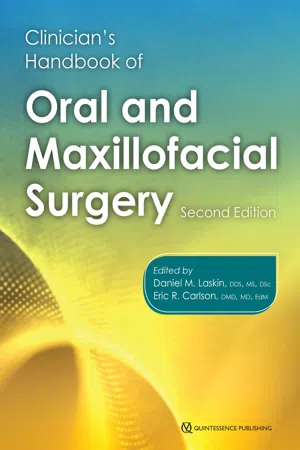
Clinician's Handbook of Oral and Maxillofacial Surgery
Second Edition
- 624 pages
- English
- ePUB (mobile friendly)
- Available on iOS & Android
Clinician's Handbook of Oral and Maxillofacial Surgery
Second Edition
About this book
"There are frequent situations in which oral and maxillofacial surgeons find themselves in need of an immediate answer to a clinical problem. However, this can involve a time-consuming search for the appropriate reference source. This book continues the format of the previous edition by providing a single place to quickly find information on a diverse range of clinical topics, including dentoalveolar surgery, maxillofacial trauma, craniofacial anomalies, and oral pathology. All of the previous chapters have been updated, and new chapters on implantology, cleft lip and palate, maxillofacial reconstruction, oral squamous cell carcinoma, and cosmetic surgery have been added. Moreover, increasing the size of the book has allowed for the inclusion of many summary charts, tables, clinical photographs, and radiographs, which was not possible in the previous version. As a result, this new edition provides expanded information in an improved format.Although this book is designed as a quick reference source, familiarizing oneself with its content in advance will both add to the reader's general knowledge base and improve the ability to find information quickly in urgent situations. Residents in oral and maxillofacial surgery should find its content particularly useful during their clinical training, and the concise organization of the material should also be helpful to them in retaining information when subsequently preparing for the American Board of Oral and Maxillofacial Surgery. "
Frequently asked questions
- Essential is ideal for learners and professionals who enjoy exploring a wide range of subjects. Access the Essential Library with 800,000+ trusted titles and best-sellers across business, personal growth, and the humanities. Includes unlimited reading time and Standard Read Aloud voice.
- Complete: Perfect for advanced learners and researchers needing full, unrestricted access. Unlock 1.4M+ books across hundreds of subjects, including academic and specialized titles. The Complete Plan also includes advanced features like Premium Read Aloud and Research Assistant.
Please note we cannot support devices running on iOS 13 and Android 7 or earlier. Learn more about using the app.
Information


Table of contents
- Cover
- Half Title Page
- Title Page
- Copyright Page
- Contents
- Preface
- Contributors
- 1 Hospital Protocol and Procedures
- 2 Patient Evaluation
- 3 Laboratory Tests and Their Interpretation
- 4 Diagnostic Imaging
- 5 Interpretation of the Electrocardiogram
- 6 Management of Fluids and Electrolytes
- 7 Nutrition for the Surgical Patient
- 8 Use of Blood and Blood Products
- 9 Basic Patient Management Techniques
- 10 Management of the Medically Compromised Patient
- 11 Management of Postoperative Medical Problems
- 12 Management of Medical Emergencies
- 13 Diagnosis and Management of Emergencies Related to Sedation and Anesthesia
- 14 Managing Complications of Dentoalveolar Surgery
- 15 Implantology
- 16 Management of Head and Neck Infections
- 17 Diagnosis and Management of Dentofacial Anomalies
- 18 Diagnosis and Management of Cleft Lip and Palate
- 19 Diagnosis and Management of Craniofacial Abnormalities
- 20 Differential Diagnosis and Management of TMDs and Orofacial Pain
- 21 Differential Diagnosis and Management of Cysts and Tumors
- 22 Diagnosis and Management of MRONJ
- 23 Differential Diagnosis and Management of Salivary Gland Diseases
- 24 Differential Diagnosis and Management of Oral Mucosal Lesions
- 25 Differential Diagnosis of Intraosseous Lesions
- 26 Differential Diagnosis and Management of Oral Squamous Cell Carcinoma
- 27 Differential Diagnosis and Management of Neck Masses
- 28 Management of Craniomaxillofacial Trauma
- 29 Head and Neck Reconstruction
- 30 Diagnosis and Management of Nerve Injuries
- 31 Cosmetic Surgery
- Index